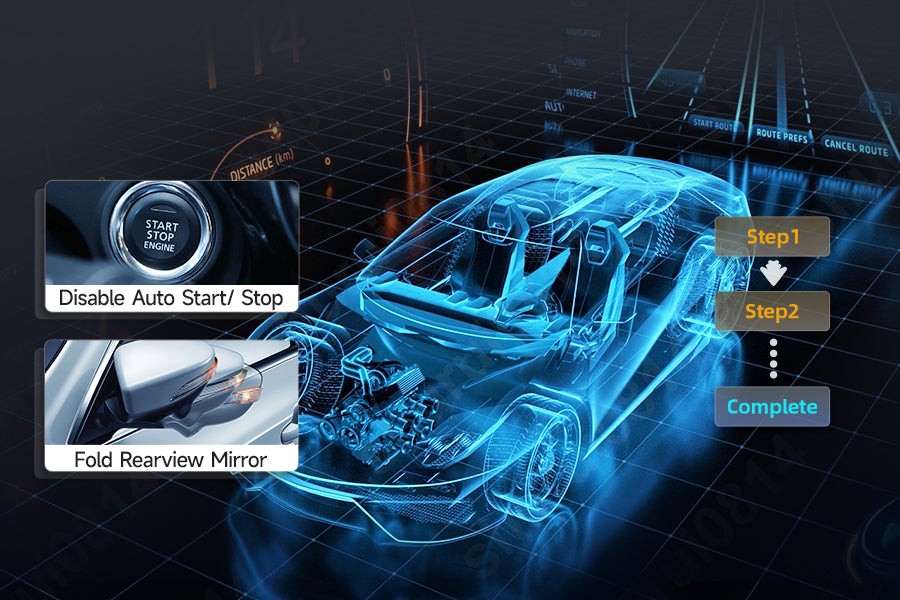Modern vehicles are equipped with sophisticated On-Board Diagnostics (OBD) systems that constantly monitor your car’s performance. When an issue arises, these systems generate diagnostic trouble codes, often indicated by the dreaded check engine light. Typically, these codes are accessed and cleared using an OBD2 scanner. But what if you find yourself without one? As a seasoned mechanic, I’m here to guide you through effective methods to delete those codes and turn off that pesky light, even without a scanner.
Understanding Why You Might Need to Reset Car Codes
Before we delve into the methods, it’s important to understand why clearing these codes might be necessary. Resetting your car’s computer, and consequently its error codes, can be useful in several situations:
- Eliminating Lingering Error Messages: Once a vehicle issue is resolved, the error code might persist, keeping the check engine light illuminated. Resetting the codes ensures your dashboard accurately reflects the current state of your car, preventing confusion from old, irrelevant alerts.
- Passing Emission Tests: Many jurisdictions require vehicles to pass emissions tests. A check engine light, even if triggered by a previously fixed problem, can cause your car to fail. Clearing the codes post-repair can be essential for passing these tests.
- Temporary Check Engine Light Turn-Off: In situations where immediate professional repair isn’t possible, resetting codes can temporarily turn off the check engine light. This is not a permanent fix and shouldn’t replace proper repairs, but it can provide temporary relief and allow you to address the issue at a more convenient time.
Important Note: While these methods can clear codes and turn off the check engine light, they do not fix the underlying problem that triggered the code. It’s crucial to diagnose and repair the root cause of the issue to prevent further damage and ensure your vehicle’s long-term health.
Proven Methods to Delete Car Codes Without an OBD2 Scanner
Let’s explore several reliable methods to reset your car’s computer and clear diagnostic codes when an OBD2 scanner isn’t available.
1. The Battery Disconnection Method: A Simple Reset
Disconnecting your car’s battery is a straightforward way to reset the vehicle’s computer and clear stored codes. Here’s a step-by-step guide:
- Ensure Ignition is Off: Turn off your car completely and remove the keys from the ignition. This is a crucial safety precaution to prevent electrical surges during battery disconnection.
- Locate the Car Battery: Open your car’s hood and find the battery. It’s typically located in the engine bay, but in some models, it might be under the rear seat or in the trunk.
- Disconnect the Negative Terminal: Using a wrench of the correct size, carefully loosen and remove the nut on the negative battery terminal. This terminal is usually black and marked with a “-” sign. Disconnecting the negative terminal first minimizes the risk of accidental shorts.
- Wait for at Least 15 Minutes: Allow sufficient time for the car’s computer to fully discharge and reset. A 15-minute wait is generally recommended. Some mechanics advise pressing the brake pedal a few times during this waiting period to help drain any residual electrical charge.
- Reconnect the Negative Terminal: After waiting, carefully reconnect the negative battery cable to its terminal and tighten the nut securely with your wrench. Ensure a firm connection.
- Start Your Vehicle: Turn on your car’s ignition and check if the check engine light has been turned off. If it has, the code reset was successful.
Important Considerations: Disconnecting the battery will reset not only the error codes but also other electronic settings in your car, such as your radio presets, clock, and potentially even seat and mirror positions. Be prepared to reset these features after reconnecting the battery. Also, in some newer vehicles, this method might not be as effective due to more complex computer systems.
2. Fuse Box Method: Targeting the ECU
Another method involves removing the fuse that specifically powers your car’s Engine Control Unit (ECU), the computer that manages the engine and emissions systems. This method can sometimes be more targeted than a full battery disconnect.
- Turn Off the Engine: Make sure your car is completely off before proceeding to the fuse box.
- Find the Fuse Box: Consult your car’s owner’s manual to locate the fuse box. Common locations include under the dashboard, in the glove compartment, or in the engine compartment.
- Identify the ECU Fuse: Refer to the fuse box diagram, usually printed on the fuse box cover or in your owner’s manual, to identify the fuse for the ECU or ECM (Engine Control Module). The label may vary depending on your car’s make and model.
- Remove the ECU Fuse: Using a fuse puller (often found in the fuse box) or needle-nose pliers, carefully pull out the identified ECU fuse. Be gentle to avoid damaging the fuse or its slot.
- Wait for 15 Minutes: Allow the system to reset by waiting for at least 15 minutes with the fuse removed.
- Reinsert the ECU Fuse: After the waiting period, firmly push the ECU fuse back into its designated slot, ensuring it is securely seated.
- Start the Car and Check: Turn on your car and check if the check engine light has been reset.
Note: This method is more specific than battery disconnection and might be preferred if you want to minimize the resetting of other car systems. However, accurately identifying the correct ECU fuse is crucial, so always refer to your car’s manual.
3. The Drive Cycle: Resetting Through Vehicle Operation
In some instances, performing a specific “drive cycle” can reset the car’s emissions system monitors and clear certain types of codes, particularly those related to emissions. This method relies on running the car through a series of driving conditions that trigger the OBD system’s self-tests.
While the exact drive cycle procedure can vary slightly between manufacturers, a general approach is as follows:
- Cold Start Procedure: Start your car after it has been completely off and the engine is cold for at least eight hours. This ensures a proper starting point for the system checks.
- Idle Phase: Let the engine idle in park (P) or neutral (N) for approximately two minutes. This allows the engine to reach a stable idle state and initiate certain system checks.
- Steady Speed Driving: Drive at a consistent speed between 50 and 55 mph (80-88 km/h) for about 15 minutes on a relatively flat, straight road. This simulates highway driving and allows the system to evaluate performance under normal load.
- Stop-and-Go Driving: Engage in stop-and-go driving in city traffic conditions for another 15 minutes. This simulates urban driving patterns and tests the system under varying speeds and loads. Include at least five stops and starts during this phase.
- Idle Cool Down: Allow the car to idle again for about two minutes before turning the engine off. This completes the drive cycle sequence and finalizes the system checks.
After completing the drive cycle, check if the check engine light has turned off. It may take a few drive cycles for the system to fully reset, and this method is most effective for clearing emissions-related codes.
4. Utilizing a Low-Cost OBD2 Bluetooth Adapter and Smartphone App
While this isn’t strictly “without a scanner,” using a Bluetooth OBD2 adapter paired with a smartphone app offers a very affordable and user-friendly alternative to a dedicated OBD2 scanner. These adapters are readily available online at a low cost and can be incredibly useful.
- Plug in the OBD2 Adapter: Locate the OBD2 port in your car. It’s typically found under the dashboard on the driver’s side, near the steering column. Plug the Bluetooth OBD2 adapter securely into this port.
- Download a Compatible Smartphone App: Download a reputable OBD2 app on your smartphone. Popular options include Torque Pro (Android) and OBD Fusion (iOS and Android). Many apps offer free and paid versions.
- Pair Adapter via Bluetooth: Enable Bluetooth on your smartphone and follow the app’s instructions to pair with the OBD2 adapter. This usually involves searching for Bluetooth devices and selecting the adapter from the list.
- Reset Codes Using the App: Once connected, navigate through the app’s menu to find the ” диагностические коды ” or “Fault Codes” section. Most apps provide a clear option to “Clear Codes” or “Reset Codes.” Follow the on-screen prompts to clear the stored diagnostic trouble codes.
Benefits of this Approach: This method provides a cost-effective way to not only clear codes but also to read them, giving you valuable information about why the check engine light came on in the first place. This can aid in diagnosing the underlying issue before simply resetting the light.
Conclusion: Managing Car Codes Without a Dedicated Scanner
While a dedicated OBD2 scanner is undoubtedly the most convenient tool for reading and clearing car diagnostic codes, these alternative methods offer practical solutions when you don’t have one readily available. Whether you opt for disconnecting the battery, removing the ECU fuse, performing a drive cycle, or using a budget-friendly Bluetooth OBD2 adapter and app, you can effectively manage your vehicle’s error codes.
However, remember that clearing codes is only part of the solution. It’s crucial to address the underlying mechanical or electrical issues that triggered the codes in the first place to ensure your vehicle’s continued reliable operation and prevent potential future problems. Always consult your car’s owner’s manual for specific instructions and safety precautions related to your vehicle model.
Frequently Asked Questions
Is it safe to reset car codes without a scanner?
Yes, the methods described, such as battery disconnection and fuse removal, are generally safe for most vehicles. However, always follow the instructions carefully and consult your car’s manual if you have any doubts.
Will deleting codes improve my car’s performance?
No, simply deleting codes will not directly improve performance. Resetting codes only clears the error messages and turns off the check engine light. Performance issues are resolved by addressing the underlying mechanical or electrical faults that caused the codes.
How long does it take to delete car codes using these methods?
Using methods like battery disconnection or fuse removal typically takes about 15-20 minutes, including the waiting time for the system to reset. The drive cycle method requires a longer driving period to complete.
Can these methods delete all types of car codes?
These methods are generally effective for clearing most common diagnostic trouble codes, especially generic OBD2 codes related to engine and emissions systems. However, for more complex or manufacturer-specific codes, a dedicated OBD2 scanner might be necessary for proper diagnosis and clearing.

